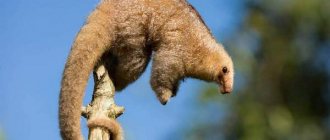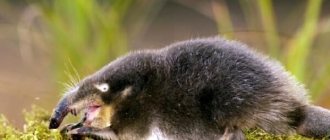- Wild animals
- >>
- Mammals
One of the most amazing mammals on our planet is the black-backed tapir . Tapirs are large herbivores from the order of artiodactyls. In appearance they resemble a pig, however, they have a trunk like an elephant. There is a legend about tapirs that the creator created these animals from the remaining parts of the bodies of other animals, and this legend has good reason.
Origin of the species and description
Photo: Black-backed tapir
Tapirus indicus (Black-backed tapir) belongs to the kingdom of animals, phylum chordates, class mammals, order equids, family tapiridae, genus tapirs, species black-haired tapir. Tapirs are amazingly ancient animals. The first ancestors of tapirs lived on our planet thirty million years ago, however, modern tapirs are practically no different from their ancestors. It is known that before the Ice Age, tapirs lived in Europe, North America and China.
Today there are only 3 types of tapirs left:
- Mexican tapir (this species lives in territories from southern Mexico to Ecuador);
- Brazilian (inhabits territories from Paraguay to Colombia);
- The mountain tapir lives in Colombia and Ecuador. Mountain tapirs are covered with thick fur.
Tapirs are somewhat similar to pigs or horses. The legs of a tapir are similar to those of a horse. The feet have three-toed hooves on the hind feet and four-toed feet on the front feet. And also on the feet there are calluses like a horse. Tapirs have a rather large body, a small head on which there is a movable trunk. These animals are born in the same color with which their ancestors used to live: light stripes run against a dark background and stretch from head to tail.
The black-backed tapir is distinguished by the presence of a large light spot on its fur on its back and sides. In 1919, Georges Cuvier, the famous paleontologist, made a statement that all large animals had been discovered by science, however, a few years later he added another amazing animal to his work “Natural History” - the tapir.
Relationship
In both morphological and molecular phylogenetic analyses,[3] T. kabomani
was discovered as the first divergence of three tapirs native to South America.
Morphological analysis indicated that T. kabomani's
may be the extinct species
T. rondoniensis
.[3] Molecular dating methods based on three mitochondrial cytochrome genes gave an approximate divergence time of 0.5 for
T. kabomani
and
T. terrestris
–
the T. pinchaque
clade , while
T. pinchaque
was found to have evolved into the paraphyletic
T. terrestris
complex much later (by comparison, the split between
T. bairdii
and tapirs, which lived in South America, occurred about 5 million years ago).[3]
| Tapirus | |
| T. pinchaque (mountain tapir) | |
| T. terrestris (South American tapir, other assemblages) | |
(Malayan tapir)
Appearance and features
Photo: Black-backed tapir in nature
The black-backed tapir is the largest species in the tapir family. Body length is from 1.9 to 2.5 meters. The height of the animal at the withers is from 0.8 to 1 meter. An adult weighs from 245 to 330 kg. However, there were individuals weighing half a ton. Moreover, females are larger than males. The black-billed tapir can be distinguished from other species by the large white spot on its back, which also extends down to its sides. The tapir's coat color is dark brown or black.
There is a white border at the tips of the ears. At birth, the cubs have a striped color, and only by 7 months the color changes and a large white saddle patch forms on the coat. The hair of animals of this species is short. The skin is rough and thick. The skin on the nape and head is especially dense, this protects the tapir from injury.
Video: Black-backed tapir
The tapir is a large animal with massive hooves similar to those of a horse. The gait is clumsy, but tapirs move quite quickly. The head is small in size; the head has small ears and a large flexible trunk. The trunk is formed by the upper lip and nose.
The animal's eyes are small, oval in shape. Many individuals of this species have a disease such as corneal opacity, so most tapirs have poor vision. However, this is compensated by a very good sense of smell and touch. The tapir has a small tail. The animal's legs are similar in structure to those of a horse, however, they are much shorter.
Where does the black-backed tapir live?
Photo: Black-backed tapir in Thailand
In the wild, tapirs live in Southeast Asia; these amazing animals can also be found in the central and southern regions of Thailand, Malaysia, Miami, and also on the island of Sumatra. These animals can be found in small numbers in the tropical forests of southern Cambodia and Vietnam. Tapirs live in dense, humid forests.
They choose places where there is especially a lot of green vegetation and where they can hide from the eyes of predators. One of the important factors when choosing a habitat is the presence of a body of water. Tapirs are excellent swimmers and spend most of their lives in water; they do not tolerate heat and spend most of the day in the pond. When bathing, small fish also join these animals; they clean the animal’s fur of various parasites.
Interesting fact: Among black-backed tapirs, there are often completely black individuals, the so-called melanists. Apart from coloring, they are no different from other representatives of this species. The lifespan of tapirs is about 30 years.
Animals try not to go out onto plains and open areas because, despite their large size, they have too many enemies. Tigers and lions, anacondas and many other predators dream of eating tapir meat. Therefore, tapirs lead a secretive lifestyle, wandering through the forest mainly at night, at night their coloring becomes a kind of camouflage, since in the dark a predator cannot distinguish the contours of the animal, seeing only a white spot, such a visual deception saves tapirs from predators.
Now you know where the black-backed tapir lives. Let's see what he eats.
Controversy
The validity of the species and the ability to reliably distinguish it from the South American tapir have subsequently been questioned in relation to both. morphological and genetic grounds. It has been noted that morphological differences between the two tapir species are particularly difficult to discern in photographs purportedly depicting T. kabomani
and it is noted that it is described in the original literature only qualitatively.[14]
Morphologically, the lack of published numerical ranges for diagnostic differences makes it extremely difficult to identify individuals in the field as little black tapirs instead of South American tapirs. The heavy reliance on indigenous peoples to define T. kabomani
was also noted in the main dissenting article. Concerns have been raised about the reliability of information when it is collected from local people, since although they are often aware of many more species in an area, they can sometimes describe haplotypes from culturally important species to be completely different species.[14]
The genetic evidence has been questioned for similar reasons. Several examined genetic sequences considered characteristic of this species, especially Cyth
The sequence of cytochrome b has been described as minimally divergent from those of other South American tapirs.[14]
Further analysis of cytochrome b sequences did reveal a clade putatively belonging to T. kabomani.
However, it has been described as diverging only to the extent that some haplotypes are found in other species.[14] Mitochondrial DNA Originally associated with morphological characters and used for description species has also been questioned.
Although few specimens of T. kabomani
were obtained, only two specimens were obtained from southwestern Amazonia, while specimens obtained from the northwest were not analyzed.[14]
The relationship between morphology and DNA of putative T. kabomani
in the northwestern areas is unknown, and it is possible that the correlation between mtDNA and morphology is not well supported.[14]
However, in addition to cytochrome b, two other mitochondrial genes, COI and COII, were analyzed, both showing the same pattern as for cytochrome b.[15] Several other objections raised against the T. kabomani
from
T. terrestris
, including external and internal morphological characters, statistical analysis, distribution and use of folk taxonomy, were reviewed in Cozzuol et al (2014).[15]
Further genetic evidence refuting T. kabomani
as a new species was published by Ruiz-Garcia et al.
(2016).[1] Ruiz-García et al found and selected tapir specimens that matched the morphological description provided by Cozzuol et al. (2013) for T. kabomani
but they only showed haplotypes of other
T. terrestris
haplogroups.[1]
Additionally, the morphological evidence for T. kabomani
has been refuted by further studies.[16]
Dumba et al. re-evaluated the variation in skull shape among tapir species and found that T. kabomani
and
T. terrestris
showed significant overlap in skull morphology, although it could still be distinguished by its broad forehead.[16]
What does the black-backed tapir eat?
Photo: Black-backed tapir from the Red Book
Tapirs are herbivores.
The diet of tapirs consists of:
- leaves of various plants;
- fruits and vegetables;
- berries;
- branches and shoots of bushes;
- moss, mushrooms and lichens;
- grass and algae.
Tapirs love salt most of all; their bodies often absorb it; tapirs can travel great distances in search of this delicacy. They also need to eat chalk and clay; these substances are an excellent source of beneficial microelements. While tapirs are in the water, they pluck algae with their trunks, eat plankton, and tear off branches from flooded bushes. The tapir has an excellent device for getting food - its trunk. With its trunk, the tapir picks leaves and fruits from trees and puts them in its mouth.
Despite their external clumsiness, tapirs are quite hardy animals and during drought they can travel long distances in search of food. In some areas, these cute and calm animals can cause major damage. Tapirs can trample and eat leaves and branches on plantations where chocolate trees are grown; these animals are also partial to sugar cane, mangoes and melons, and can harm the plantings of these plants. In captivity, tapirs are fed the same food as pigs. Tapirs love to eat crackers and various sweets. Can eat oats, wheat, and other grains, fruits and various vegetables.
Nutrition
The basis of the nutritious diet is plants of the local tropics: green leaves of plants, ripe berries. Since the animal loves to dive, it often forages for algae.
A real delicacy is salt. Because of this, animals have to travel long distances. In Paraguay, concentrations of animals often appear in the lowlands. The earth is rich in sodium salts, which they absorb along with the soil. This is how the deficiency of useful microelements and vitamins is eliminated.
If tapirs live outside their freedom, then the minimum area should be 20 m2 and there must be a body of water nearby. The diet is the same as that of pigs: feed, grass, fruits. Slow development is observed due to a lack of natural light and, as a result, a lack of vitamin D. When kept by people, vitamins are added to the feed. The list of favorite foods also includes sweet fruits, crackers, and cane sugar. When domesticating, it is important to ensure that the mammal receives the necessary organic elements to maintain health.
Features of character and lifestyle
Photo: Black-backed tapir
In the wild, tapirs are very secretive animals and are nocturnal. During the daytime, these animals spend almost the entire day in the water. There they hide from predators and the hot sun. And also, these animals are always not averse to taking mud baths, this relieves them of the parasites living on their fur and gives the animals great pleasure. Tapirs swim well, including underwater, and can get food there. Sensing danger, a tapir can dive into the water and not appear on the surface for some time.
At night, tapirs roam the forest in search of food. These animals see very poorly, but poor vision is compensated by a good sense of smell and touch; in the dark they navigate by sounds and smells. Tapirs are very timid; when they hear a rustle or feel that an animal might be hunting for them, they will run away quickly. During the daytime, they try not to leave the thickets or water, so as not to become a victim of a predator.
Tapirs lead a solitary lifestyle, with the exception of the mating season, when the male meets the female to give birth and raise offspring. At other times, animals behave aggressively towards their relatives, they do not allow them into their territory, even during migration; tapirs migrate alone or in pairs of a male and a female. To communicate with each other, tapirs make ringing sounds similar to whistling. Seeing his relative next to him, the tapir will try in every possible way to drive him away from his territory.
Interesting fact: tapirs are mentally developed on the same level as domestic pigs. Despite the fact that in the wild, these animals behave aggressively, they very quickly get used to life in captivity, begin to obey people and understand them.
Social structure and reproduction
Photo: Black-backed tapir calf
The mating season for tapirs falls at the end of spring, usually the end of April - May. But sometimes they happen in June. In captivity, tapirs are ready to breed all year round. Before mating, tapirs have real mating games: the animals make very loud whistling sounds, by these sounds the females can find the male in the forest thickets, and the male can find the female. During mating, the animals circle, bite each other, and make loud sounds.
The initiator of mating is the female. The female's pregnancy is very long-term and lasts up to 410 days. Basically, only one baby is born to tapirs; very rarely twins are born. The female cares for the cub, she feeds it and protects it from dangers.
After birth, the cub sits in a shelter for some time, but at the age of one week the cub begins to walk with its mother. Small tapirs have protective striped coloring that will change over time. For the first six months, the female feeds the cub with milk; over time, the cub switches to plant food, starting with tender foliage, fruits and soft grass. Tapir cubs grow very quickly and by the age of six months a young tapir becomes the size of an adult. Tapirs are ready to breed at the age of 3-4 years.
Animal in the Moscow Zoo
Our tapir is a female, born in 1986, and came to us from the Berlin Zoo in 2005. Tapirs are herbivorous animals, so the zoo receives boiled potatoes and carrots, lettuce, various fruits, rolled oat porridge with peas, to which vitamins and mineral supplements are added, as well as special feed.
Since the female is no longer young, she has, as they say, character. Any new event or change in the usual routine of life is treated with suspicion. For example, the arrival of mechanics or electricians can unsettle her for half a day, and the need to move to the neighboring cage, where the giraffe is usually kept, while cleaning, turns into a serious problem. Of course, when working with such an animal, special techniques are needed that, on the one hand, make working with it easier, and on the other hand, help the animal cope with inevitable and not always pleasant events. To do this, special classes are regularly carried out with the tapir, during which the animal “obtains” a treat from the keeper, performing simple but necessary actions for care. For example, an animal was taught that in order to get a grape, it needs to touch its nose to a special object - a target. The target is a plastic pin. Thanks to this training, for half a bowl of grapes, a keeper can guide an animal through an enclosure, into an adjacent cage, and even transfer it across the road from a winter enclosure to a summer enclosure and back. Previously, this procedure cost everyone a lot of effort, nerves and time.
Old age also requires serious attention to the health of the animal: veterinary examination, weight monitoring, monitoring the condition of the hooves and, if necessary, treatment. In order for the tapir to allow all these manipulations to be carried out on him, and most importantly, so that they do not cause him stress, special training is also carried out. The animal is taught to go on the scale, allow its legs to be examined, and allow its hooves to be processed if necessary.
As a result of the training, the tapir became more relaxed about all these procedures, and his life became more active and eventful.
Natural enemies of black-backed tapirs
Photo: Black-backed tapir in nature
These cute animals have many enemies in the wild. The main enemies of tapirs include:
- cougars;
- jaguars and tigers;
- crocodiles;
- Anaconda snake;
- caymans.
Tapirs hide in water from large predators of the cat family, as these animals do not like water. But tapirs face another danger in the water: crocodiles and anacondas. Crocodiles are fast and excellent at hunting in water, and it is difficult for a tapir to escape from these predators.
But the main enemy of tapirs was and remains man. It is people who cut down the forests where tapirs live. These poor animals have nowhere to live, because in open areas they immediately become the prey of predators, in addition, by cutting down forests, people deprive these animals of the most important thing - food. And also in many areas, tapirs are destroyed by people in order to preserve the harvest.
It is known that these animals harm crops and plantations of fruit and oil trees, so people drive away tapirs if they see that these animals live near crops. Although hunting for tapirs is currently prohibited, these animals continue to be destroyed because tapir meat is considered a real delicacy, and reins and whips are made from the dense skin of the animal. In recent years, due to humans, the tapir population has declined enormously, and the species is on the verge of extinction.
Population and species status
Photo: Pair of black-backed tapirs
Due to the fact that about 50% of the forests in tapir habitats have been cut down in recent years, and the remaining forests are beyond the reach of tapirs, the number of animals has sharply decreased. In the places where these animals used to live, only 10% of the forests remain that are suitable for tapirs to live. In addition, animals are often persecuted by people for damaging and destroying crops. Animals are often killed or injured by negligence when they are driven off plantations.
Interesting fact: If a tapir gets into farms and other areas protected by dogs, when attacked by dogs, tapirs do not run away, but show aggression. If a tapir is driven into a corner by a dog, it may begin to bite and attack. In addition, a tapir, sensing danger, can attack a person.
Today, the species Tapirus indicus The black-backed tapir is listed in the Red Book and has the status of an endangered species. Hunting animals of this species is prohibited by law, however, tapirs are destroyed in large numbers by poachers. Tapirs are especially vulnerable during migration, when they are forced to go out into open areas.
If people don’t stop cutting down forests and hunting tapirs, these animals will soon disappear. Most tapirs now live in protected reserves, but these animals reproduce little. It is very difficult to track the exact number of tapirs in the wild due to the fact that the animals are nocturnal and very secretive. In addition, tapirs can migrate from their usual habitats in search of food, and it can be difficult to determine their new location.











